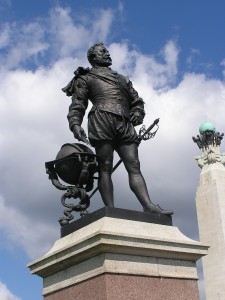Drake’s statue on Plymouth Hoe
The career of Sir Francis Drake is a current fascination. Drake’s famous circumnavigation of the globe included a landing in California on 17 June 1579. He needed a secluded spot at which to careen his ship, The Golden Hinde (that is, to beach her, tip her on her sides and scrape the barnacles from her hull). There was a risk that the Spaniards, whom he had already robbed of a fortune in bullion, might come looking for him. The eyewitness accounts say that Drake landed at a latitude of 38 degrees North. (This could be accurately measured with a quadrant; determining longitude was more problematical.) The likeliest landing place is therefore accepted to be about 30 miles north of San Francisco, a wild and beautiful spot where the ‘white bankes and cliffes’ reminded Drake of home. Drake’s Bay owes its name to Fleet Admiral Chester W. Nimitz, who lived not far away, in a house with panoramic views over San Francisco Bay. Drake was fearful of the Indians and built a rough stone wall to defend his camp. In fact, the local Niwok were friendly and treated Drake like a king. He called the territory ‘Nova Albion’ and claimed it for the Queen. He fastened a metal plate to a strong post to record the fact, inserting a silver sixpence into a specially cut hole to show Elizabeth’s picture. Such a plate was ‘discovered’ there in 1936, but was later revealed to be a hoax on the part of some artful students. Drake and his crew, who lingered until 23 July, even travelled inland to mingle with the hospitable Niwok, apparently planting their seed among them. Expeditions in 1772 and 1774 discovered tribesmen with fair hair and, even more unusually, beards. As Drake was incapable of producing issue by either of his two wives, it is perhaps unlikely that any were descended from him. Drake’s Bay appears still to be sparsely populated, with seals basking on deserted beaches. The white cliffs are indeed strikingly reminiscent of southern England. How strange it must have been for Drake and his crew, who were as far away as it was possible to be from their homes. Those who survived the many hazards of the voyage were to be set up for life.
